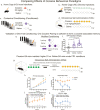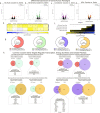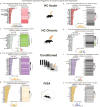Cocaine induces paradigm-specific changes to the transcriptome within the ventral tegmental area
- PMID: 34155331
- PMCID: PMC8357835
- DOI: 10.1038/s41386-021-01031-4
Cocaine induces paradigm-specific changes to the transcriptome within the ventral tegmental area
Abstract
During the initial stages of drug use, cocaine-induced neuroadaptations within the ventral tegmental area (VTA) are critical for drug-associated cue learning and drug reinforcement processes. These neuroadaptations occur, in part, from alterations to the transcriptome. Although cocaine-induced transcriptional mechanisms within the VTA have been examined, various regimens and paradigms have been employed to examine candidate target genes. In order to identify key genes and biological processes regulating cocaine-induced processes, we employed genome-wide RNA-sequencing to analyze transcriptional profiles within the VTA from male mice that underwent one of four commonly used paradigms: acute home cage injections of cocaine, chronic home cage injections of cocaine, cocaine-conditioning, or intravenous-self administration of cocaine. We found that cocaine alters distinct sets of VTA genes within each exposure paradigm. Using behavioral measures from cocaine self-administering mice, we also found several genes whose expression patterns corelate with cocaine intake. In addition to overall gene expression levels, we identified several predicted upstream regulators of cocaine-induced transcription shared across all paradigms. Although distinct gene sets were altered across cocaine exposure paradigms, we found, from Gene Ontology (GO) term analysis, that biological processes important for energy regulation and synaptic plasticity were affected across all cocaine paradigms. Coexpression analysis also identified gene networks that are altered by cocaine. These data indicate that cocaine alters networks enriched with glial cell markers of the VTA that are involved in gene regulation and synaptic processes. Our analyses demonstrate that transcriptional changes within the VTA depend on the route, dose and context of cocaine exposure, and highlight several biological processes affected by cocaine. Overall, these findings provide a unique resource of gene expression data for future studies examining novel cocaine gene targets that regulate drug-associated behaviors.
© 2021. The Author(s).
Figures







